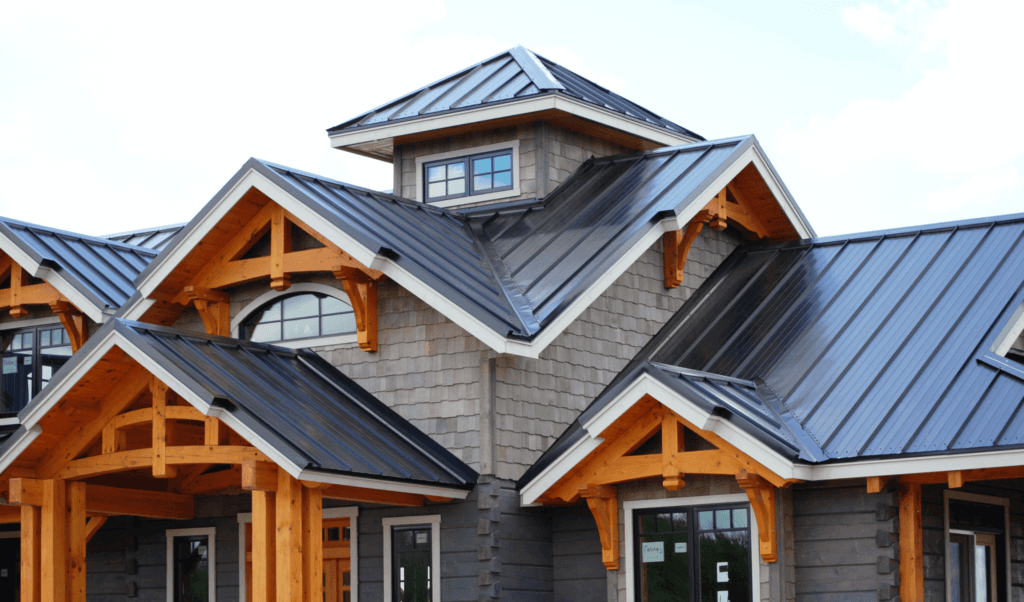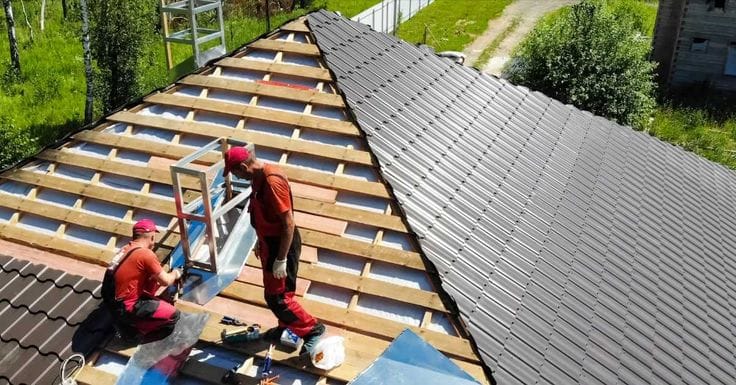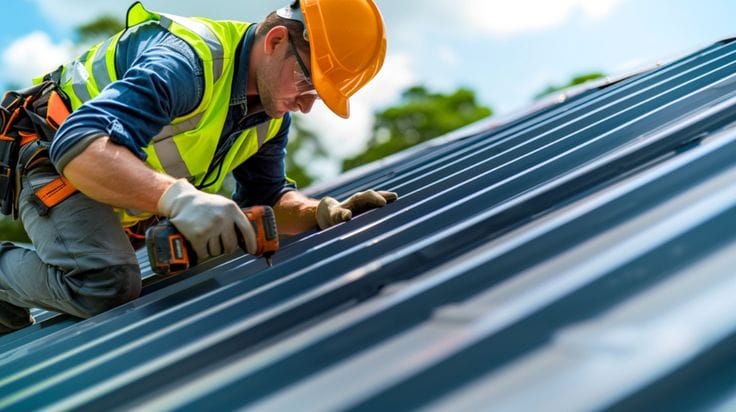- Free Estimates

A roof is one of the most critical components of a home, providing protection, insulation, and structural integrity. However, not all roofing installations are done correctly. Poor workmanship can lead to leaks, energy inefficiencies, and costly repairs down the line.
So, how can you tell if your roofing job was done right? Here are nine key indicators of expert roofing work, so you can be sure your home is in good hands.
Key Takeaways |
✔ Proper underlayment adds a moisture barrier to prevent leaks.
✔ Strong roof decking supports shingles and prevents sagging.
✔ Correct flashing installation seals penetrations and prevents water damage.
✔ Precise shingle alignment enhances durability and aesthetics.
✔ Adequate ventilation prevents heat buildup, moisture, and roof failure.
✔ Drip edges protect against water damage by directing rainwater away.
✔ Thorough cleanup after installation reflects professionalism and quality.
✔ Hiring a reputable roofing company ensures durability and long-term performance.
A professional roofing company ensures proper underlayment installation, which serves as a secondary barrier against moisture, wind-driven rain, and ice dams. Without it, water can seep through, leading to rot, mold, and structural damage.
Roof decking, also known as sheathing, is the wooden foundation that supports the entire roofing system. A professional roofing company in Danbury, CT, will inspect and replace deteriorated decking to prevent sagging, leaks, and premature roof failure.
Flashing is a thin, weather-resistant metal used to prevent water infiltration around chimneys, vents, skylights, and valleys. The best roofing company near me in Danbury, CT, should ensure flashing is securely fastened and sealed, using high-quality materials like galvanized steel or copper. Proper flashing installation extends the lifespan of your roof by preventing water damage in vulnerable areas.
Professional roofing company services ensure flashing is installed with the following characteristics:
Improper flashing installation is one of the most common causes of roof leaks and structural damage. Homeowners should be aware of these common flashing issues:
Improper layering with shingles: If flashing is installed on top of shingles rather than underneath, it can fail to divert water properly, increasing the risk of leaks.
Proper shingle installation is key to ensuring both long-lasting roof protection and a polished appearance. When aligned correctly, shingles form a seamless barrier against wind, rain, and snow, while also boosting curb appeal. A professional roofing installation guarantees shingles are properly placed and secured, maximizing the roof’s durability and efficiency. Homeowners should regularly inspect their roofs for signs of misalignment, loose shingles, or exposed nails to catch potential issues early.
When shingles are not installed correctly, it can lead to premature roof failure. Some common issues include:

Proper roof ventilation is essential for maintaining energy efficiency and preventing moisture buildup. A roofing company in Danbury, CT, should install intake and exhaust vents strategically to promote air circulation and reduce issues like mold growth and ice dams.
A well-ventilated roof provides several benefits:
Drip edges are essential metal strips installed along the edges of your roof to direct water away from the fascia boards and into the gutters, preventing moisture from seeping under the shingles and causing rot or structural damage. For maximum effectiveness, a drip edge must be securely fastened along the roofline and extended slightly beyond the edge to ensure proper water runoff.
The best roofing company near me in Danbury, CT, will use durable, corrosion-resistant materials such as aluminum, galvanized steel, or copper to ensure long-lasting protection and optimal performance.
A missing or poorly installed drip edge can lead to serious roofing issues, including water damage, rot, and premature deterioration of roofing materials. To avoid these problems, homeowners should ensure their contractor includes a properly installed drip edge as part of the roofing system. When correctly positioned and secured, the drip edge helps channel water away from the fascia and other vulnerable areas, preserving the structural integrity of the roof. Regular inspections can help catch early signs of rust, damage, or improper installation—allowing for timely repairs that extend the life of your roof.
A properly sealed roof is essential for preventing leaks, enhancing energy efficiency, and increasing the overall lifespan of the roofing system. Sealing involves applying protective materials to vulnerable areas such as joints, edges, and roof penetrations to prevent moisture from entering the home. Without adequate sealing, homeowners may face significant structural issues, including rotting wood, damaged insulation, and mold growth. Regular roof inspections are crucial for identifying sealing problems early, ensuring long-term protection for the home.
A properly sealed roof will:
Homeowners should consider hiring a professional roofing company to help inspect the following indicators of a well-sealed roof:
A roof that lacks proper sealing is prone to water damage, structural deterioration, and costly repairs.
. Common signs of poor waterproofing include:
A properly installed roof should have a smooth, level surface with no dips, bumps, or sagging. Uneven areas not only affect the roof’s appearance but also create places where water can pool, increasing the risk of leaks, structural strain, and premature deterioration of roofing materials. A flat, uniform roof ensures water flows efficiently into the gutters, protecting your home from moisture-related damage.
Uneven roofing surfaces often point to deeper installation or structural issues—such as a weak foundation, subpar materials, or poor workmanship. Achieving a level roof starts with a solid framework, high-quality materials, and expert installation. Regular inspections are key to identifying early signs of unevenness and addressing them before they lead to costly repairs or long-term damage.
A properly installed roof will have:
A roof that appears uneven can be a sign of underlying installation or structural issues. Common causes of an uneven roof include:
A professional roofing company should leave your property clean and safe after installation. This includes removing nails, debris, and old materials, using magnetic sweepers to collect stray nails, and clearing gutters of roofing debris. Reliable roofing company services also include final inspections and detailed war
A well-executed post-installation cleanup should include:
A quality roofing installation isn’t complete without thorough documentation and a clear warranty. Professional roofing companies prioritize transparency by providing homeowners with detailed records of the work performed and warranties that offer peace of mind long after the job is done.
Warranties typically come in two forms: a manufacturer’s warranty that covers roofing materials, and a workmanship warranty that covers the contractor’s labor. These warranties are essential in protecting your investment, ensuring that any issues resulting from faulty materials or installation are resolved without additional out-of-pocket costs.
Additionally, well-documented roofing projects are valuable for future resale, insurance claims, and home maintenance planning. Without proper documentation, proving the age or quality of your roof can become difficult, potentially affecting your home’s value or insurability.
Inspection records and project photos: Some contractors provide before-and-after photos and inspection notes for added transparency.

Look for signs like straight and evenly spaced shingles, properly sealed flashing, secure underlayment, and an absence of dips or sagging. A high-quality installation will have smooth surfaces and proper ventilation.
Common mistakes include improper shingle alignment, inadequate nailing, lack of underlayment, poorly installed flashing, and insufficient ventilation. These issues can lead to leaks, energy inefficiencies, and premature roof failure.
Proper ventilation prevents heat and moisture buildup in the attic, reducing the risk of mold, wood rot, and ice dams. It also extends the lifespan of shingles and helps maintain energy efficiency in the home.
Inspect for straight and uniform shingles, properly sealed flashing, correct drip edge installation, and adequate ventilation. Also, ensure a thorough cleanup was performed by the roofing company.
Flashing prevents water from seeping into roof penetrations and joints, reducing the risk of leaks and water damage. Poorly installed or missing flashing is a leading cause of roof failure.
A properly installed roof protects your home and prevents costly repairs. Recognizing the signs of quality workmanship helps homeowners address issues early and extend their roof’s lifespan. If you notice any concerns, acting quickly can save time and money.
For expert roofing company services, the Roofing Contractor of Danbury is a trusted choice. They specialize in high-quality roof installations, repairs, and maintenance, ensuring precision workmanship and durable materials.
Don’t let minor roofing issues escalate. Schedule a free roof inspection with the Roofing Contractor of Danbury today and keep your home secure for years to come.
247 Franklin Street Ext Danbury, CT 06811
860-773-5040